Influencer Vetting: 6 Critical Red Flags Brands Should Avoid
Curious how to master influencer vetting?
You’re asking the right question.
Influencer marketing is booming, and brands are investing heavily in creators because the returns are undeniable — up to 11x ROI.
Look at some of the biggest names in the industry:
Gymshark leveraged influencer marketing to achieve 200% YoY growth, with sales reaching $681 million in 2022.
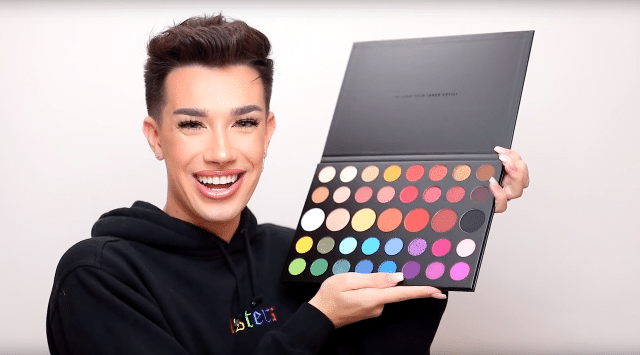
But here’s the problem: brands can easily waste their budget if they invest in the wrong influencer. Just ask Snapchat.
They paid influencer Luka Sabbat $60K to promote their Spectacles on Instagram, with a contract for multiple posts and stories.
What happened? Sabbat didn’t fulfill the agreement—he failed to post all the required content or wear the product as specified.
The result? Snapchat sued him for breach of contract, and valuable resources were wasted.
So, how do you ensure your match is the right one? In this guide, I’ll walk you through the process of influencer recruitment and share all the steps to conduct a proper influencer check to ensure your partnership is a success.
Let’s dive in and explore how to vet influencers effectively.
-> How to Vet Influencers: Biggest Red Flags
-> Influencer’s Metrics to Check
-> How to contact the influencer
-> Conclusion
Ready? Let’s dive in! 👇
How to Vet Influencers: Biggest Red Flags
I’ve had the chance to speak with 8 seasoned experts in influencer marketing, each with years of experience working alongside creators.
They were kind enough to share some of their insider wisdom with me.
So, let me pass it on to you—the biggest red flags to watch for when vetting influencers:
1. Unaligned Brand Values
The first thing you need to consider when you vet influencers is whether the creator’s content aligns with your brand’s message and overall vibe. If not, it’s best to move on.
Luiza Girardello, Influencer Marketing Manager at Semrush , highlights this point:
The most critical factor to consider is whether the influencer’s values align with the company’s, ensuring a genuine partnership that reflects shared principles.
A prime example of misalignment?
Kylie Jenner promoting the phone game Travel Town left people scratching their heads. Her audience is all about beauty and fashion—not mobile gaming. It simply didn’t connect with her followers.
2. Background Controversies
When you vet influencers, you also need to check the influencer’s background for any controversial content that could potentially harm your brand. Without a thorough influencer background check, you may end up with more headaches than results.
Taruna Vinaykiya, Influencer Marketing Manager, recommends:
Watch out for problematic and controversial content. This includes offensive, racist, sexist, or homophobic remarks, as well as any history of bullying, aggression, or inflammatory behavior, drugs and alcohol—even if posted years ago.
Taruna also advises to leverage platforms that allow keyword searches across an influencer’s social media history to flag concerning content. A simple Google search, like “influencer name + controversy,” can reveal past incidents when you vet influencers.
Dan Albert, the Founder of 456 Growth , adds:
The way we vet influencer partners has drastically evolved. If before it was all about audience demographics, now brands choose influencers based on their reputation.
Albert adds that brands’ attention when vetting influencers has moved toward evaluating creators based on variables such as engagement rate and brand safety.
He also suggests including a morals clause in your brand agreement:
Creators can provide immense value with their reach, but they can also damage your brand in seconds. An influencer’s public persona may seem clean and safe, but a deeper dive into their community engagement might reveal values that don’t align with your brand. Always vet for potential risks to your brand image.
3. Low Engagement Rate
Engagement rate is another crucial factor to consider when you vet influencers. It shows how invested an influencer’s audience is in their content.
Different platforms and account sizes have varying benchmarks, but in general, a low engagement rate can be a major red flag.
I typically want to see an engagement rate of at least 2%. If this isn’t the case, then it signifies an audience that’s not interested in the influencer, or it could mean fake followers.
When vetting influencers, watch for red flags like sudden follower growth spikes. It means potential bot activity.
4. Lack of Interest in Previous Sponsored Content
It’s also important to evaluate how an influencer’s audience reacts to sponsored content. An influencer might have high engagement on organic posts, but if their sponsored content underperforms, it’s a red flag.
Katie Stoller, founder of an influencer marketing agency, shares:
The biggest red flag I look for is a lack of interest in previous sponsored content. Sometimes, someone can have a deeply engaged audience for organic content and just miss the mark with sponsored work.
She advises paying attention to these signs:
1️⃣ Disengaged or random comments on previous sponsored posts (which could indicate fake followers or engagement pods)
2️⃣ Lower-than-average shares and saves
3️⃣ Lower-than-average engagement (likes and comments)
Katie says it’s okay not to hit all three areas perfectly when you vet influencers. However, if more than one of these metrics is significantly low, it indicates the audience isn’t really interested in the influencer’s sponsored posts.
5. Disproportionate Pricing
When it comes to how much influencers charge, pricing is another red flag to watch for. Since there isn’t a standardized pricing model in the industry, influencers may overcharge despite their actual performance.
To help you out in influencer vetting, here’s a chart with approximate rates based on influencer’s size:
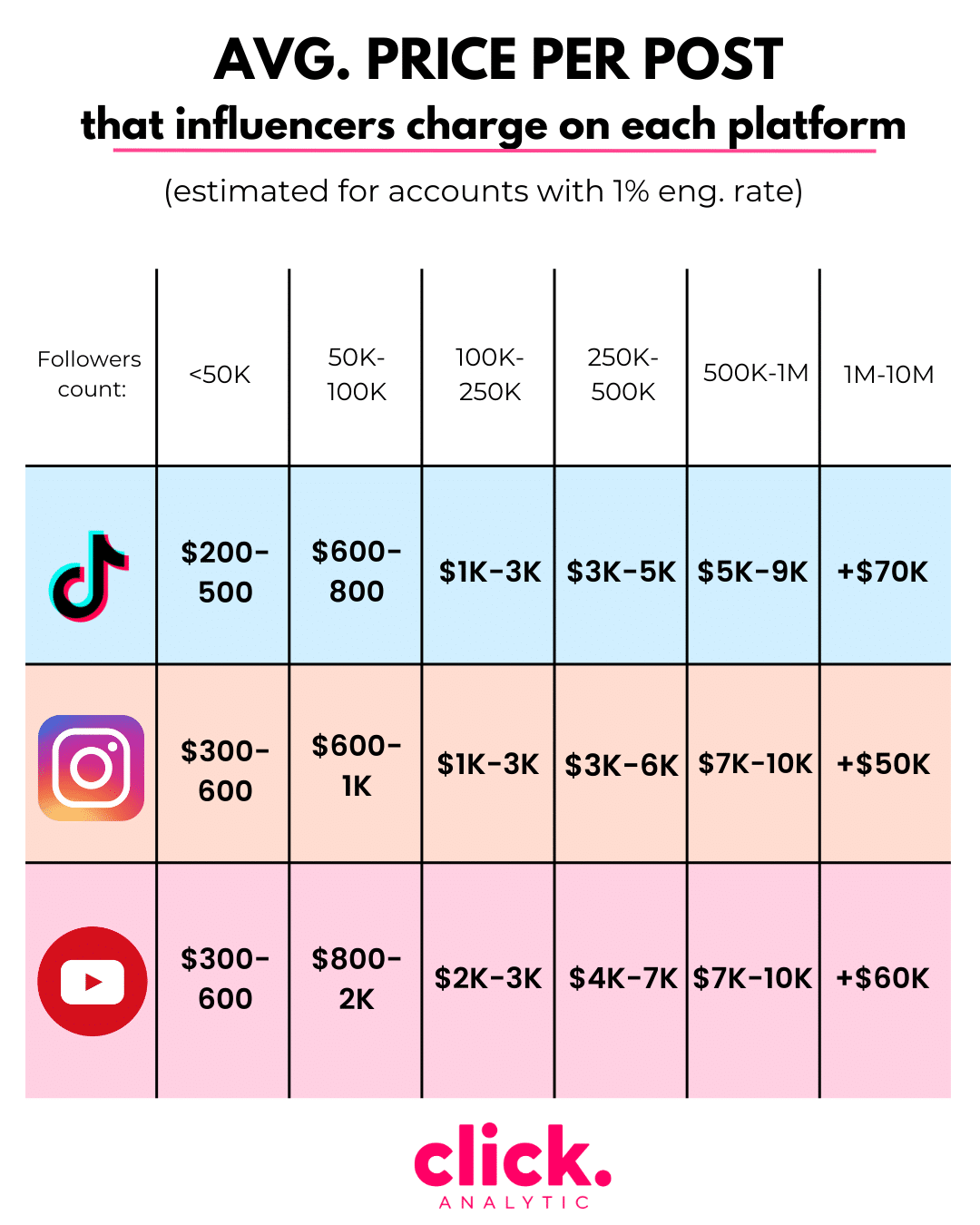
Luiza Girardello explains:
Some influencers charge disproportionately high fees that don’t align with their past performance or the value they can realistically deliver, indicating a mismatch between the creator and brand
Olivia Crowley, Founder & Social Media Marketing Manager at Living Lavish Social, echoes this concern about influencer vetting:
The biggest red flag is when an influencer’s rates do not align with their level of engagement. It’s easy for anyone to buy 20K followers today—an influencer needs to have a good level of engagement to make a campaign worthwhile!
Another red flag is when an influencer requests upfront payment. Taruna Vinaykiya warns:
Upfront payment can sometimes signal an influencer scam or a lack of confidence in the value of the partnership.
Though it could also indicate past bad experiences with late payments, it’s something worth considering before proceeding.
6. No Interest in Your Brand
To make any influencer partnership successful, it’s critical that the creator genuinely likes your product and is willing to engage long-term. If they show little interest in your brand, that’s a major red flag and not a good brand fit.
Marco Matti, Head of Digital Marketing, Media & E-Commerce at Unilever , shares:
Biggest red flags? No keen interest in the brand and its message, and a lack of pragmatic cooperation in a long-term partnership.
Dan Albert also recommends this when you vet influencers:
Look for committed creators who leverage the full suite of social platform tools—stories, posts, reels, live streams, etc.—to growth-hack their audience and increase engagement rates.
Dan Albert explains that a creator who isn’t committed to a strategic content deployment will always underperform in the long run. It’s important to consider during the influencer audit.
My conclusion?
As Katie Stoller wisely advised: “Don’t just focus on metrics; evaluate content quality, storytelling, and alignment with your brand.”
That’s the best way to ensure you’re not falling into any traps.
Now that you know what to avoid during your influencer vetting process, it’s time to determine your campaign goals and find the perfect match to help your brand succeed!
Determining goals
Before diving into the process of influencer vetting or conducting an influencer check, it’s essential to have a clear understanding of what you want to achieve with your campaign.
Defining your objectives from the outset provides a roadmap that will guide your influencer recruitment and help you measure success.
Let’s break down some common goals:
1. Increase Brand Awareness
If your primary goal is to boost brand recognition, start with effective influencer vetting to seek out authentic influencers with a broad reach.
Typically, these are mid- and macro-influencers who, through careful influencer vetting, can introduce your brand to a wider, more diverse audience, significantly elevating brand awareness.
But there’s a catch.
Influencers with large followings often have lower engagement rates. And who wants to invest in influencers with an inactive audience? This is where proper influencer vetting becomes essential.
An influencer vetting tool like Click Analytic can help you assess influencers by checking their engagement rates in seconds, ensuring their audience is both real and actively engaged with the content!
2. Drive Sales
Looking to drive sales? You’ll need influencers with a proven ability to convert. In many cases, micro-influencers are the way to go.
Why? Their audiences tend to be more engaged, and they are often perceived as more relatable and trustworthy.
📊 In fact, 82% of consumers are highly likely to follow a recommendation from a micro-influencer.
So, when sales are your primary objective, micro-influencers can be powerful partners in generating real results.
3. Grow Social Media Following
Want to grow your social media presence? Begin with careful influencer vetting to find influencers with an engaged following on the platforms you’re targeting. This helps ensure that exclusive content, special offers, or promotions will effectively reach your intended audience.
With proper influencer vetting, you can turn their loyal audience into your own as the influencer encourages followers to engage with your brand through exclusive content and special offers.
Not sure which type of partnership will work best for your campaign? Don’t worry—solid influencer vetting will help you make informed decisions.
For more insights, check out our detailed guide on the benefits and disadvantages of influencer marketing, where we break down different types of influencer partnerships and the importance of influencer vetting.
Voilà! Now you’re equipped to partner with influencers who align with your brand goals. With effective influencer vetting, you’ll be better positioned to select influencers who help you achieve measurable success.
Let’s dive deeper into how to properly vet influencers. Here are the essential metrics to focus on during the influencer vetting process:
Influencer’s Metrics to Check
To determine if a creator is the right fit for your brand, effective influencer vetting requires evaluating several key metrics.
And here’s the good news—you can handle influencer vetting effortlessly in seconds with the Click Analytic tool. Let me walk you through the influencer vetting process step by step:
Engagement Rate
We’ve touched on this before, but it’s worth repeating.
A good influencer should have an engagement rate of 2% or higher. This ensures their audience is active and engaged.
With Click Analytic, you can filter influencers by engagement rate, automatically eliminating those with disengaged or inactive followers.
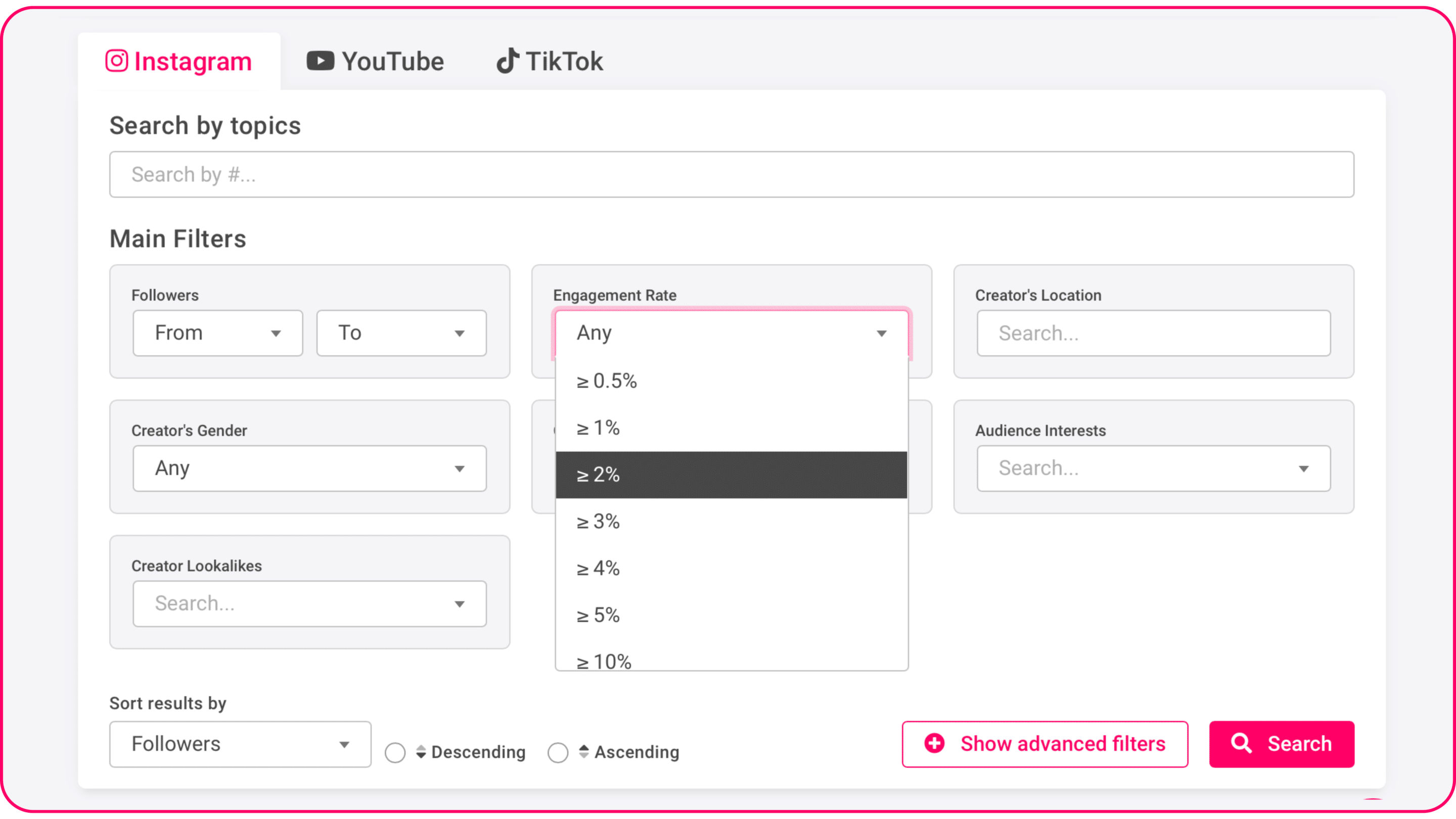
Average Views
If your campaign involves video content, knowing how many views you can expect is crucial.
Whether it’s TikTok or Instagram, Click Analytic streamlines the influencer vetting process, allowing you to quickly check an influencer’s average view count and gauge the potential impact of your collaboration.
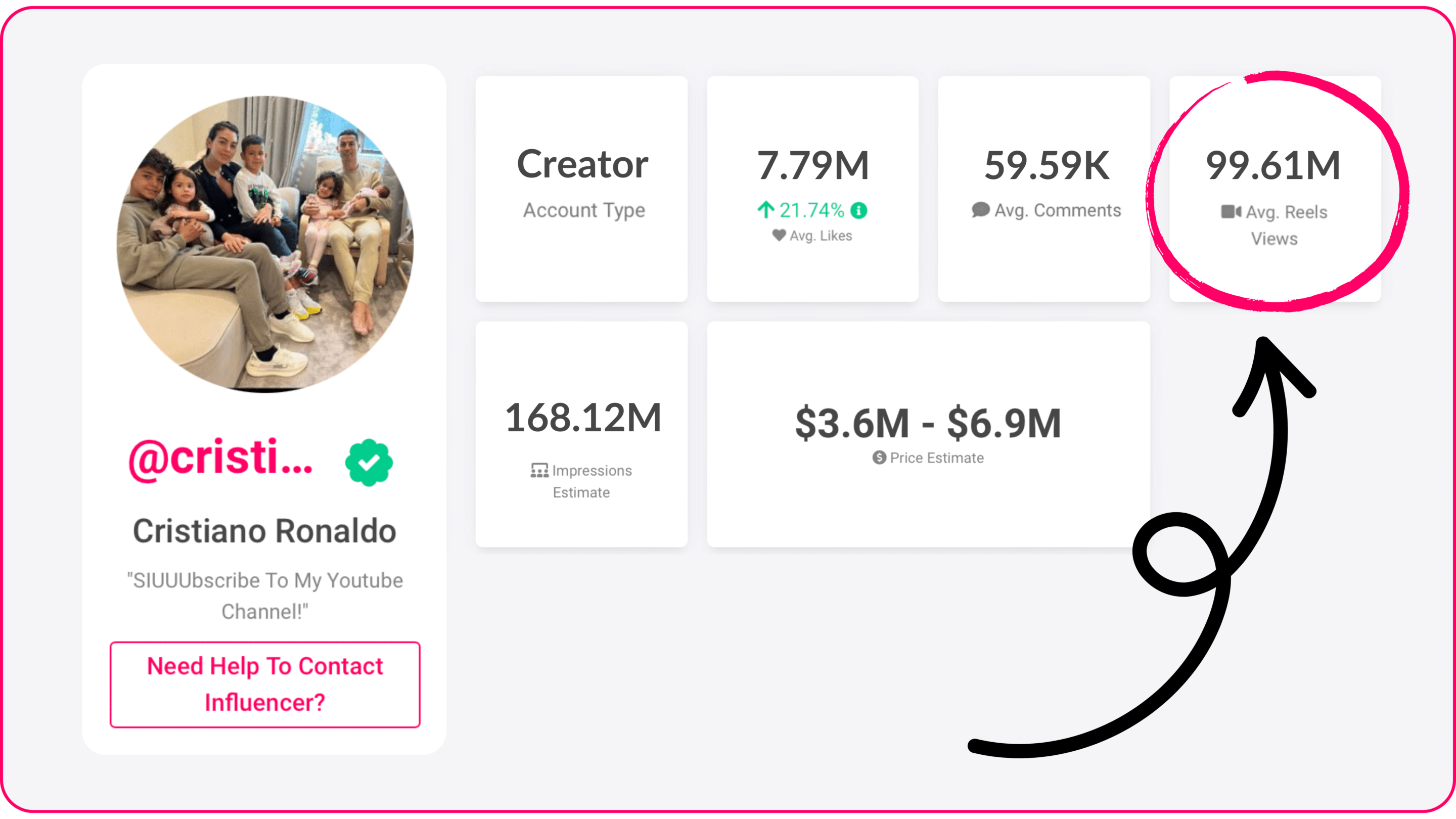
Audience Demographics
As a brand, you’ve likely developed a clear customer profile. When conducting influencer vetting, it’s essential to ensure that an influencer’s audience aligns closely with your target demographic.
With Click Analytic, the influencer vetting process lets you dive into crucial details like audience location, age, gender, language, and interests. You’ll also get access to an audience authenticity score, which is critical in verifying that you’re not just reaching bots 🤖 but real, engaged followers.
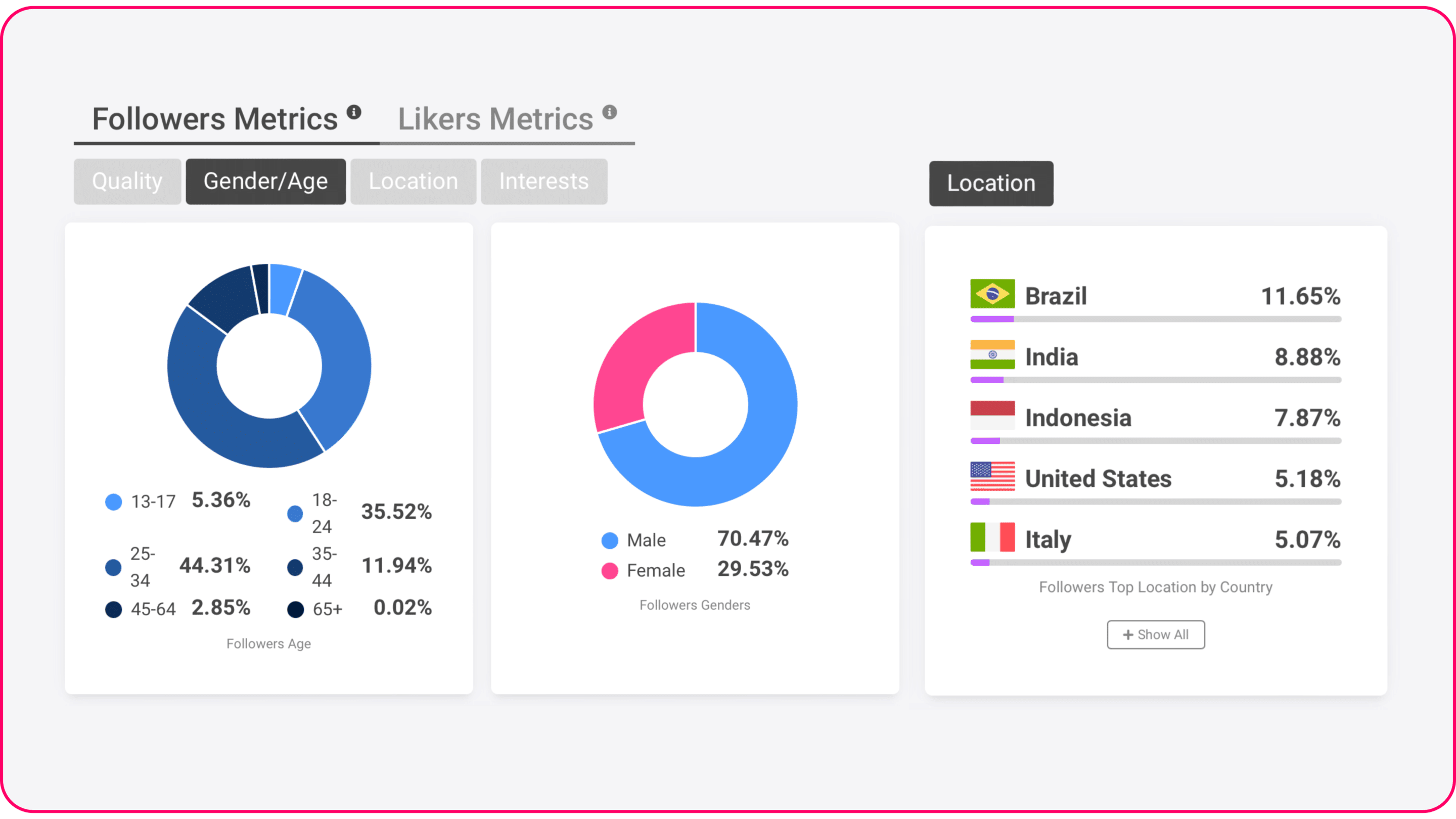
Estimated Impressions
If brand visibility or awareness is your goal, you’ll want to know the potential reach of the influencer’s posts.
Don’t skip checking the estimated impressions per post during your influencer vetting process—this gives you an idea of how many people will actually see the content.
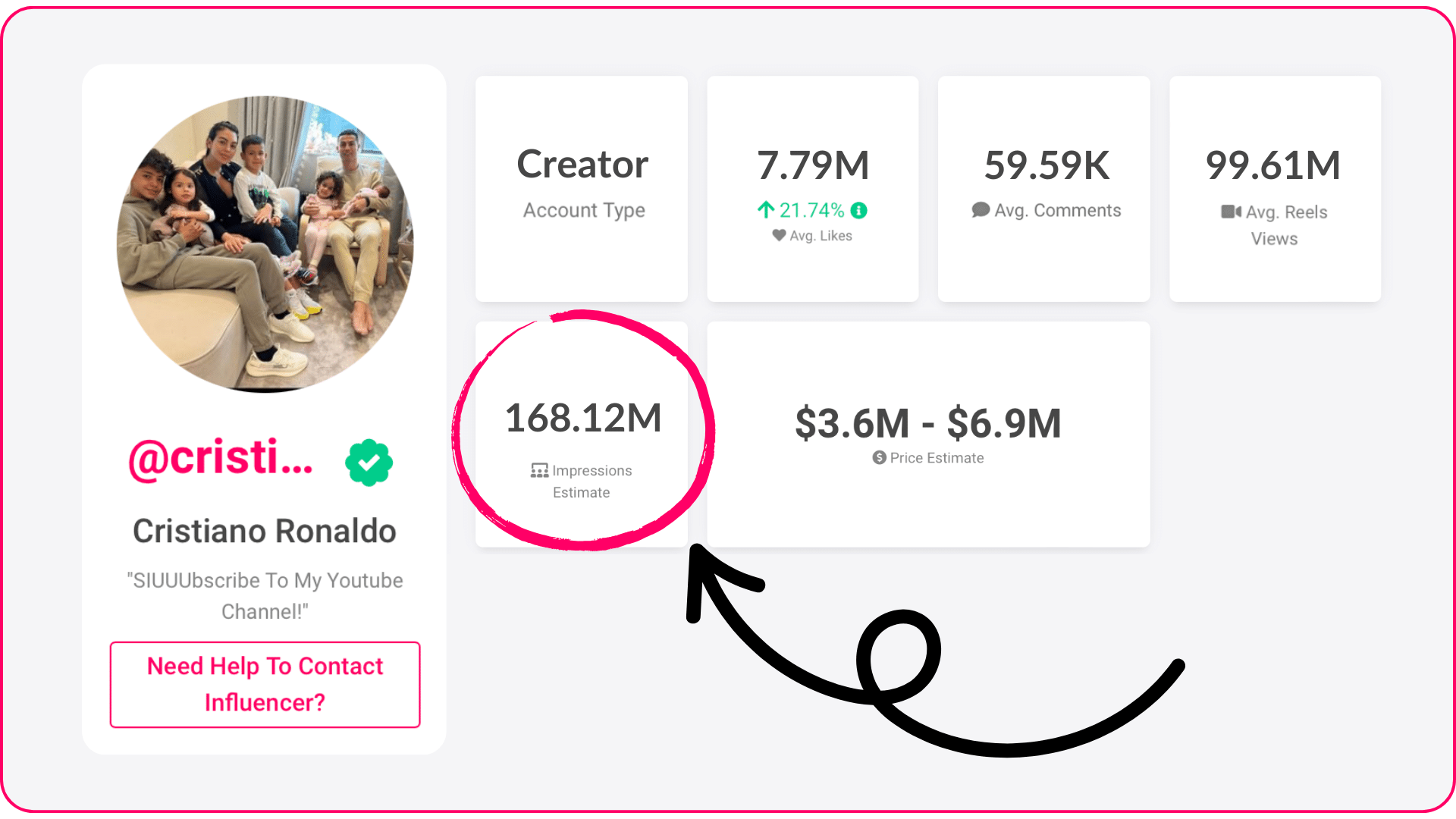
Follower Growth
With Click Analytic, you can track follower growth month by month.
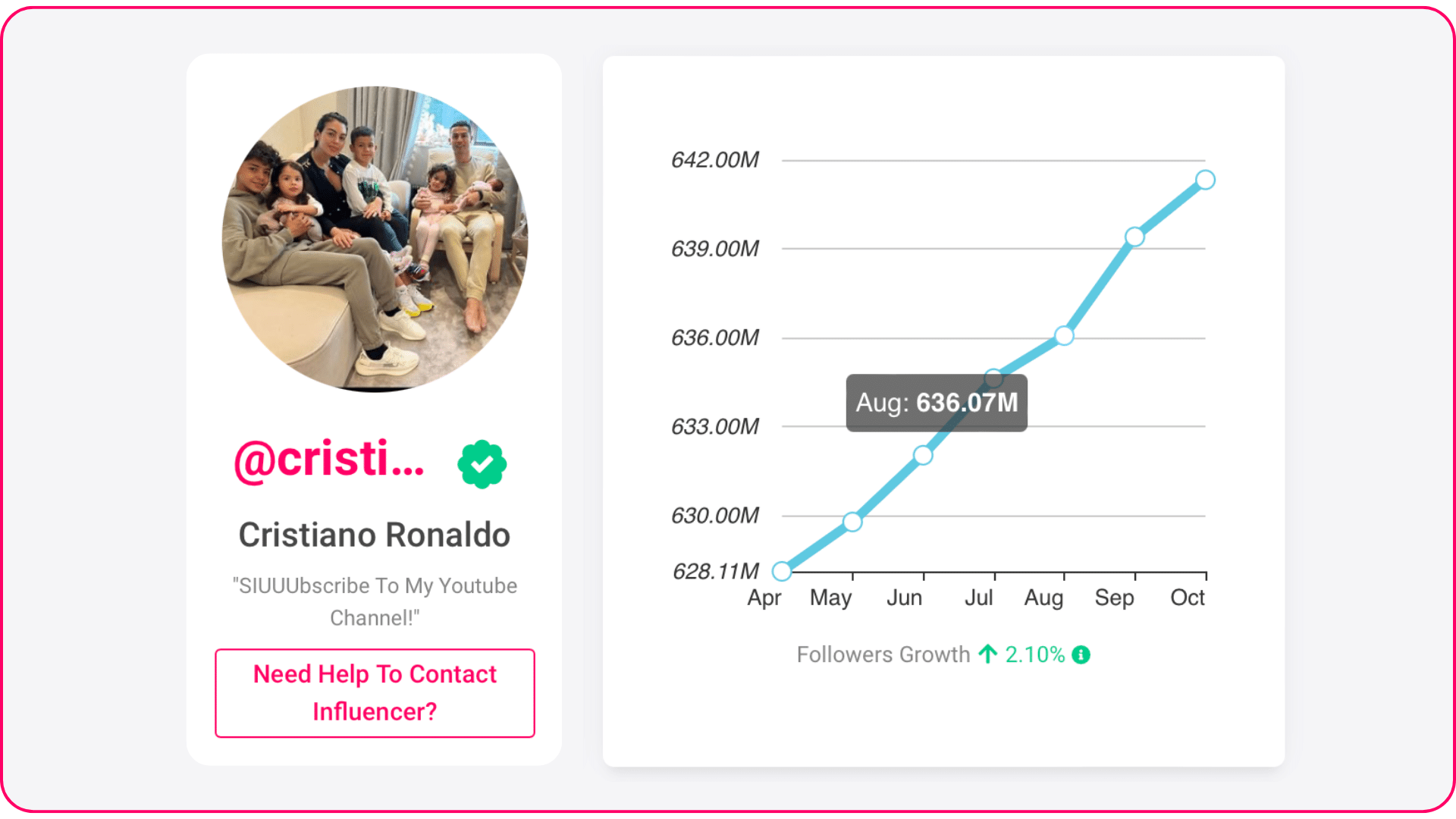
But there’s one last thing—how do you reach out once you’ve found your ideal match through effective influencer vetting?
Let me share this wisdom with you:
How to contact the influencer
Email vs. DM
First things first—where should you reach out to an influencer after completing your influencer vetting process?
Many brands today opt for DMs, but here’s my take: contacting influencers via email boosts your credibility and authority.
Plus, it keeps all your negotiation history in one place, which can be incredibly helpful when managing influencer vetting and communications.
That said, DMs can serve as a great starting point, especially when email addresses are hard to track down. They also offer a gentle, casual way to follow up.
Curious about the pros and cons of email versus DM outreach?
Check out this insightful article for more details: Email vs. DM Outreach.
Outreach to Creators
Once you’ve identified the best channel for contacting influencers, it’s time to initiate outreach. I have a secret strategy that has helped me achieve a response rate of over 70%.
Here are my tips:
1️⃣ Automate as Much as Possible (While Leaving Room for Personalization)
Use email automation tools to streamline your outreach process. Send personalized greetings and introductions to free up your time for crafting compelling collaboration proposals..
Manually reaching out to dozens of influencers can be overwhelming, which is why Click Analytic offers an outreach tool that allows you to contact hundreds of influencers simultaneously while automating follow-ups.
2️⃣ A/B Test Your Messages
Experiment with different subject lines, email lengths, and calls to action (CTAs) to see what resonates best with your audience. Analyzing this data can significantly improve your response rate.
3️⃣ Volume Outreach
If you aim to work with 10 influencers, don’t hesitate to reach out to 100. The more you cast your net, the better your chances of success.
If you’re interested in mastering influencer outreach, check out my ultimate 5-step guide here: Influencer Outreach Guide.
Compile a Brief
Once you’ve negotiated with the creator, it’s time to secure the deal.
A brief serves as legal documentation of your requirements and intentions, so don’t overlook this step! Here are three essential checkpoints to include:
Set Clear Goals
Define measurable goals that you can use to assess your success later on.
Prepare KPIs and Objectives
Identify your key goals and deliverables to ensure everyone is on the same page.
Detail Your Product’s Features
Include a thorough description of your product’s key features, pricing, and benefits. This clarity will serve as your guiding star throughout the partnership.
My main advice? Don’t micromanage the influencer’s creativity. Provide key messaging about your product but allow room for their personal touch and perspective.
Here’s a recap of DOs and DON’Ts:
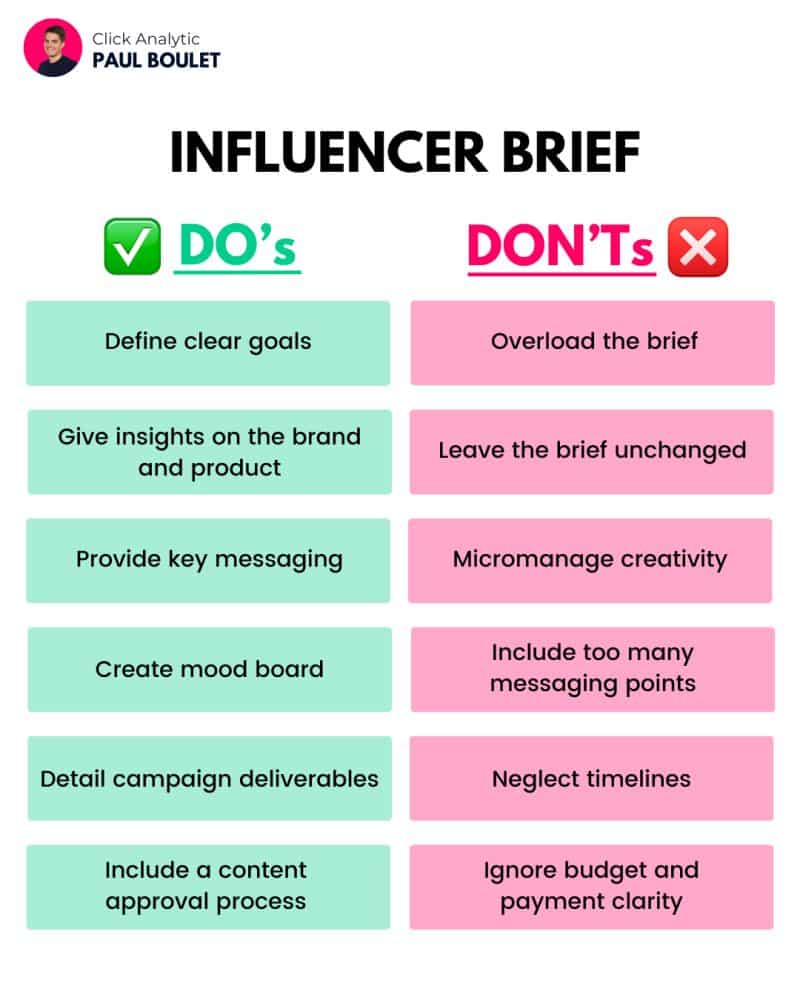
If you want to know exactly what to include in an influencer contract, be sure to check out this helpful guide: What to Include in an Influencer Contract.
And there you have it! Now I can rest easy knowing you’re equipped with the knowledge to spot red flags, effectively vet, and reach out to influencers for success in your influencer marketing efforts.
Let’s wrap things up with some final thoughts…
Conclusion
Influencer marketing is an incredibly effective channel for any brand looking to make an impact. But to truly master this space, you need to know not just who to reach out to through proper influencer vetting, but also how to connect with them.
Keep this in mind: authenticity is key. Whether you decide to partner with micro or macro influencers, choosing individuals who genuinely align with your brand values will boost your credibility and resonate more deeply with their audience. Effective influencer vetting can help you identify these genuine connections.
And don’t overlook the power of tools like Click Analytic to streamline your outreach process, aid in influencer vetting, verify engagement rates, and establish transparent relationships with your influencers.
So, gear up and get ready—your next standout collaboration is just around the corner, thanks to effective influencer vetting!
Q/A on Influencer vetting
How do I vet the right influencer for my brand?
Vetting the right influencer is all about alignment—your brand’s vibe needs to match their audience’s interests and values. This is where effective influencer vetting comes into play.
First, look at their engagement: are their followers genuinely interacting with their content, or are they just scrolling by? Proper influencer vetting will help you assess this interaction level.
Next, check their content style—is it in line with how you want your brand represented? Influencer vetting allows you to ensure that their style aligns with your branding.
And finally, look at their audience demographics. Do they match your target market? This is another critical aspect of influencer vetting.
Tools like Click Analytic make it easy to filter through millions of influencers to vet your perfect match in minutes, instead of spending hours scrolling on your own.
Also, check out our free rankings of the best influencers based on location and niches to enhance your influencer vetting process.
What’s the difference between vetting micro, macro, and celebrity influencers?
It’s all about the numbers and impact.
Micro-influencers have smaller followings (usually 10K to 100K) but often higher engagement rates because they foster a loyal, niche community. They are excellent candidates for influencer vetting when you’re focusing on targeted campaigns and driving conversions.
Macro-influencers (100K to 1M followers) offer a bigger reach, but their audience might be more general. When engaging in influencer vetting, these influencers are solid for enhancing brand awareness.
Celebrities (1M+ followers) bring massive visibility but come with a hefty price tag and sometimes lower engagement rates. Proper influencer vetting is crucial here, as it all depends on your campaign goals—awareness vs. engagement vs. conversions.
Is influencer marketing suitable for small businesses, or do you need a big budget?
You absolutely don’t need a huge budget to vet influencers.
Micro-influencers, in particular, are often affordable and offer better engagement with niche audiences. Effective influencer vetting can help you identify these cost-effective partnerships.
They work well for small businesses because they’re more authentic, have closer relationships with their followers, and often charge less than macro-influencers or celebrities. This makes influencer vetting an essential step for budget-conscious brands.
Plus, many influencers are open to product exchanges, especially if they love your brand. Influencer marketing can be tailored to fit your budget, no matter how big or small, and influencer vetting can help you find the right fit for your financial goals.
What should I include in an influencer brief?
After you’re done with influencer vetting, it’s time to compile a brief. Your influencer brief needs to cover the essentials, but leave room for creativity—that’s what influencers are great at!
First, define the campaign goals (Are you building awareness? Driving conversions?). This clarity should stem from your influencer vetting process.
Be clear about your brand’s tone, style, and must-have messaging. Include details like deadlines, content formats, and whether the influencer needs to use certain hashtags, links, or disclosure requirements. Proper influencer vetting will ensure the chosen influencer aligns with these criteria.
Finally, lay out the “do’s and don’ts”—this helps avoid any messaging mishaps. But don’t over-direct. The best influencer content feels natural, not forced, which should have been a part of your influencer vetting considerations.
To learn more about the perfect influencer brief, check out this guide
What fee do influencers charge?
Pay transparency is a hot, yet still evolving topic right now.
Creators are pushing for more standardization and visibility around rates.
Influencers want to know what others in their niche or with similar follower counts are getting paid, and brands are being called to offer fair compensation.
Some influencers are now openly sharing their rates to hold brands accountable and prevent underpayment.
It’s becoming clear: fair pay = better relationships = better content.
Brands need to ensure they’re compensating influencers fairly to maintain strong, long-lasting partnerships.



